Coronavirus Today: COVID-19’s orphans
- Share via
Good evening. I’m Karen Kaplan, and it’s Friday, Oct. 8. Here’s the latest on what’s happening with the coronavirus in California and beyond.
As COVID-19 deaths continue to mount across the country, we often point out that children infected with the coronavirus rarely become sick enough to die. But these deaths can still cause them a lifetime of heartache.
A new study in the journal Pediatrics estimates that more than 120,000 U.S. children lost a parent or grandparent who was their primary caregiver during a 15-month span of the pandemic. These were the relatives who watched them, fed them, did their laundry, made sure they got to school, provided housing, and generally made their lives possible.
Another 22,000 children lost a secondary caregiver — for instance, someone who provided financial assistance or a place to live but wasn’t in charge of all of their basic needs.
The authors of the report described all of these children as “orphans,” although some may have at least one surviving parent or other relative. Hard numbers on how many kids had to be placed in foster care as a result of the pandemic are not yet available, but researchers estimate the number of guardian-less children rose about 15% as a result of COVID-19.
UNICEF’s definition of orphans includes children who have lost one or both parents. The emotional punch that comes with the word helps convey how much the death of a single caregiver can upend a child’s life, the researchers said.
The tallies above were based on statistical models that incorporated actual and expected deaths in the U.S. from April 1, 2020, to June 20, 2021, as well as fertility rates and data on household composition.
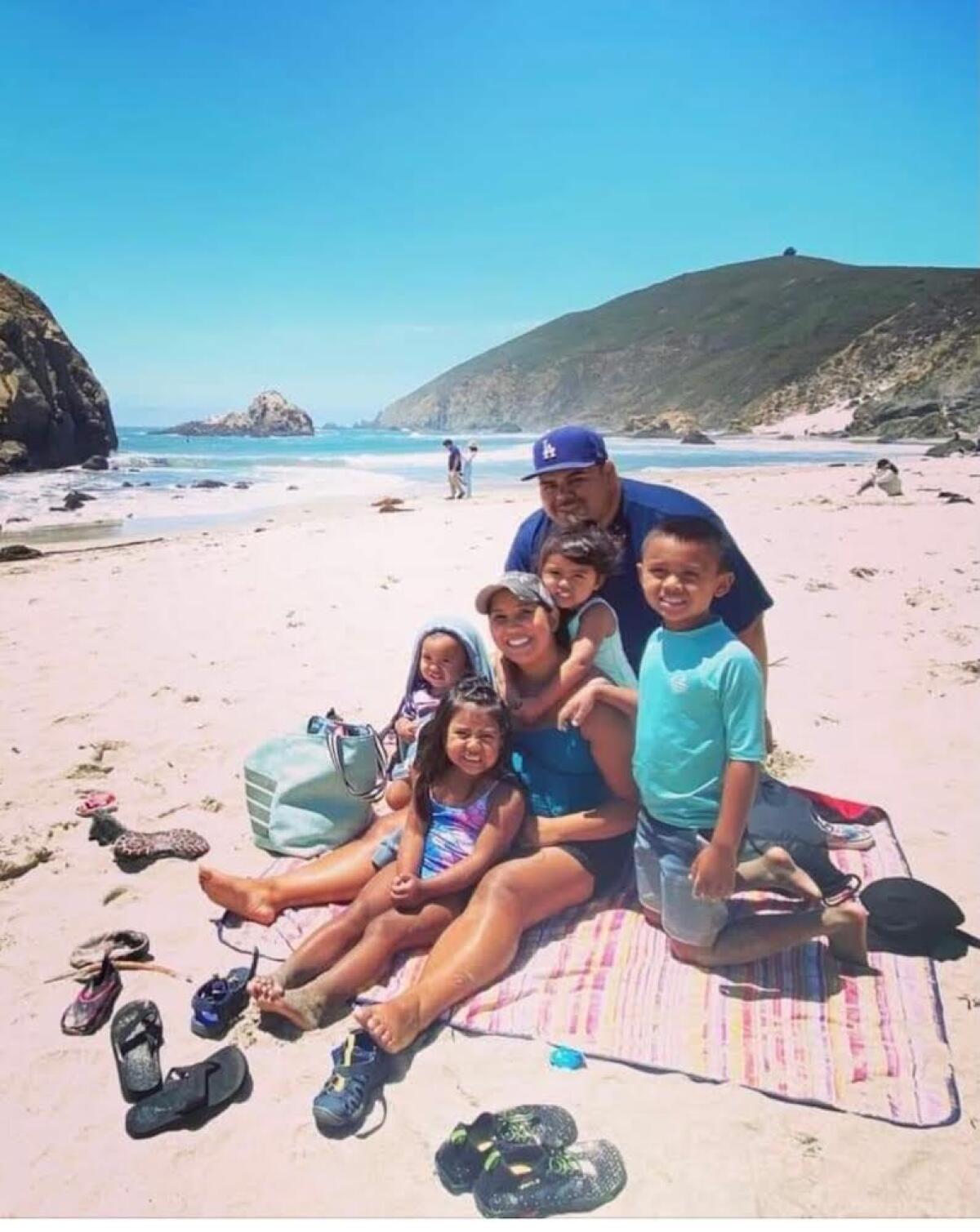
If the bigness of those numbers makes it hard for them to sink in, here’s another way to look at it: For every four COVID-19 deaths in the U.S., there is one child who has lost a parent or other caregiver.
Or how about: Roughly 1 in 500 children have lost a parent or grandparent to COVID-19.
That’s a lot of lost love.
Like so much else about the pandemic, that loss hasn’t been spread equally. Nationwide, nearly two-thirds of those who lost a primary caregiver during the pandemic were children of color.
The researchers calculated that 1 in every 168 Native American or Alaska Native children became a COVID-19 orphan. So did 1 in every 310 Black children, 1 in every 412 Latino children, 1 in every 612 Asian children and 1 in every 753 white children.
Study leader Susan Hillis, a researcher at the Centers for Disease Control and Prevention, called this tide of orphanhood “a hidden, global pandemic.”
By the numbers
California cases and deaths as of 3 p.m. Friday:

Track California’s coronavirus spread and vaccination efforts — including the latest numbers and how they break down — with our graphics.
The real-world impact of vaccine misinformation
Back in July, U.S. Surgeon General Vivek Murthy issued a formal health advisory on the dangers of misinformation and its capacity to magnify the toll of the pandemic.
“Misinformation has caused confusion and led people to decline COVID-19 vaccines, reject public health measures such as masking and physical distancing, and use unproven treatments,” the advisory states. “A recent study showed that even brief exposure to COVID-19 vaccine misinformation made people less likely to want a COVID-19 vaccine.”
You don’t have to be an academic or a public health official to see vaccine misinformation in action. You can be Hernan Hernandez, executive director of the California Farmworker Foundation in Kern County.
Through talking with farmworkers, Hernandez learned of a rumor that getting a COVID-19 vaccination would somehow alter your sexuality. The idea didn’t come from Facebook or Twitter or some other dubious news source, my colleagues Rong-Gong Lin II and Luke Money report. It was reported on a Spanish-language TV station and attributed to a rabbi in Israel.
Word of the report spread, causing 100 farmworkers who had planned on getting the vaccine to change their minds.
“Although the report was false, farmworkers saw that in their 6 p.m. news and automatically thought, ‘Well, what if it’s true?’” Hernandez said.
And that’s just one example.
“Every single week, it’s a new myth,” he said.
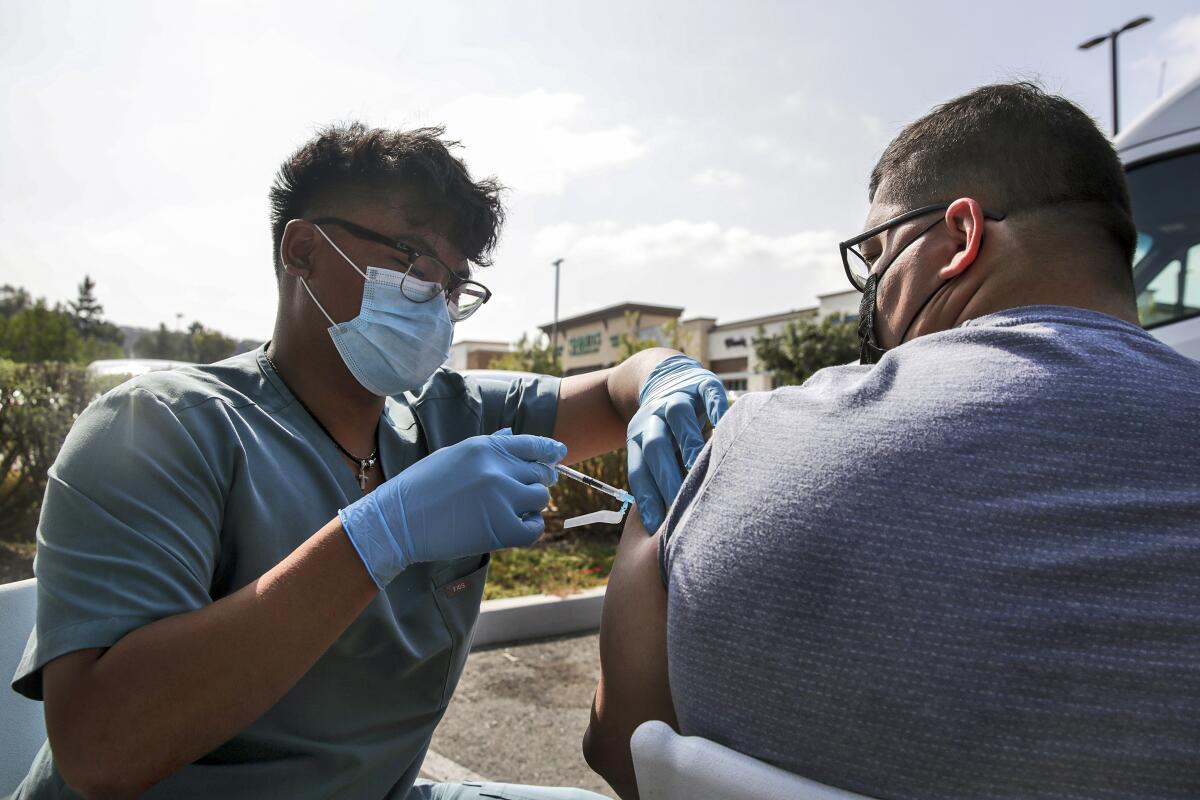
In Orange County, it’s less about sexuality and more about sexual reproduction.
“The biggest myth or fear is the fertility issue,” according to Isabel Becerra, chief executive of the Coalition of Orange County Community Health Centers. This is despite the fact that there’s not only no evidence they cause reproductive harm but also no plausible biological reason that they would.
And speaking of biological implausibility, another rumor claims COVID-19 vaccines alter a recipient’s DNA. They don’t.
(The vaccines made by Pfizer-BioNTech and Moderna use mRNA, not DNA, to give cells instructions for making a harmless version of the coronavirus’ spike protein. That prompts the immune system to make coronavirus antibodies that stick around long after the mRNA is flushed from the body.)
“It’s actually impossible for these vaccines to alter your DNA,” said L.A. County Public Health Director Barbara Ferrer. “There’s no mechanism that would allow for your DNA to be altered by these vaccines.”
Misinformation doesn’t have to be outlandish to be damaging.
Dr. Regina Chinsio-Kwong, an Orange County deputy health officer, said some people were turning down COVID-19 vaccines because they thought they needed health insurance (they don’t), that they’d be asked about their immigration status (they won’t), or that they just didn’t need them if they felt healthy (they do — the job of vaccines is to prevent illness, not cure it).
Fear of COVID-19 vaccines can be so tangible that people have asked health workers to accompany them to clinics, said Joe Prado, interim assistant director of the Fresno County Department of Public Health.
“This vaccine hesitancy is real and ... it looks different for every individual,” he said.
The antidote to misinformation, of course, is truth. And nothing conveys the truth as forcefully as the death of a loved one.
In the Riverside County community of Mecca, an esteemed priest died of COVID-19. Fear of the shot was replaced by fear of going without it.
Among those in the community who were old enough to be immunized, said Hernandez of the California Farmworker Foundation, the vaccination rate increased from 40% to virtually 100%.
California’s vaccination progress
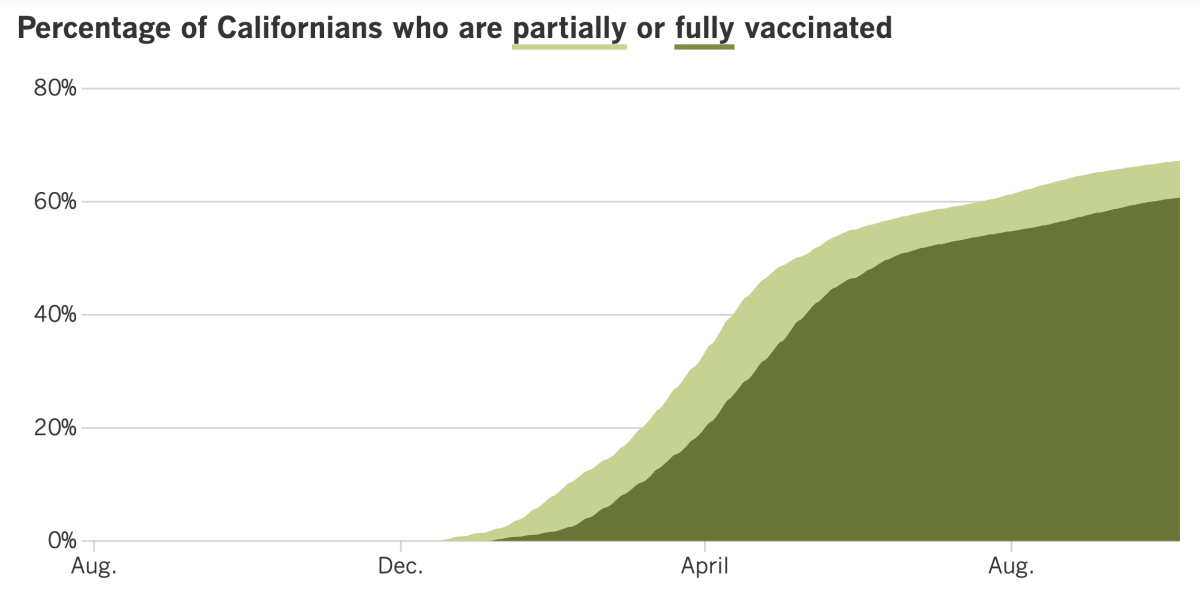
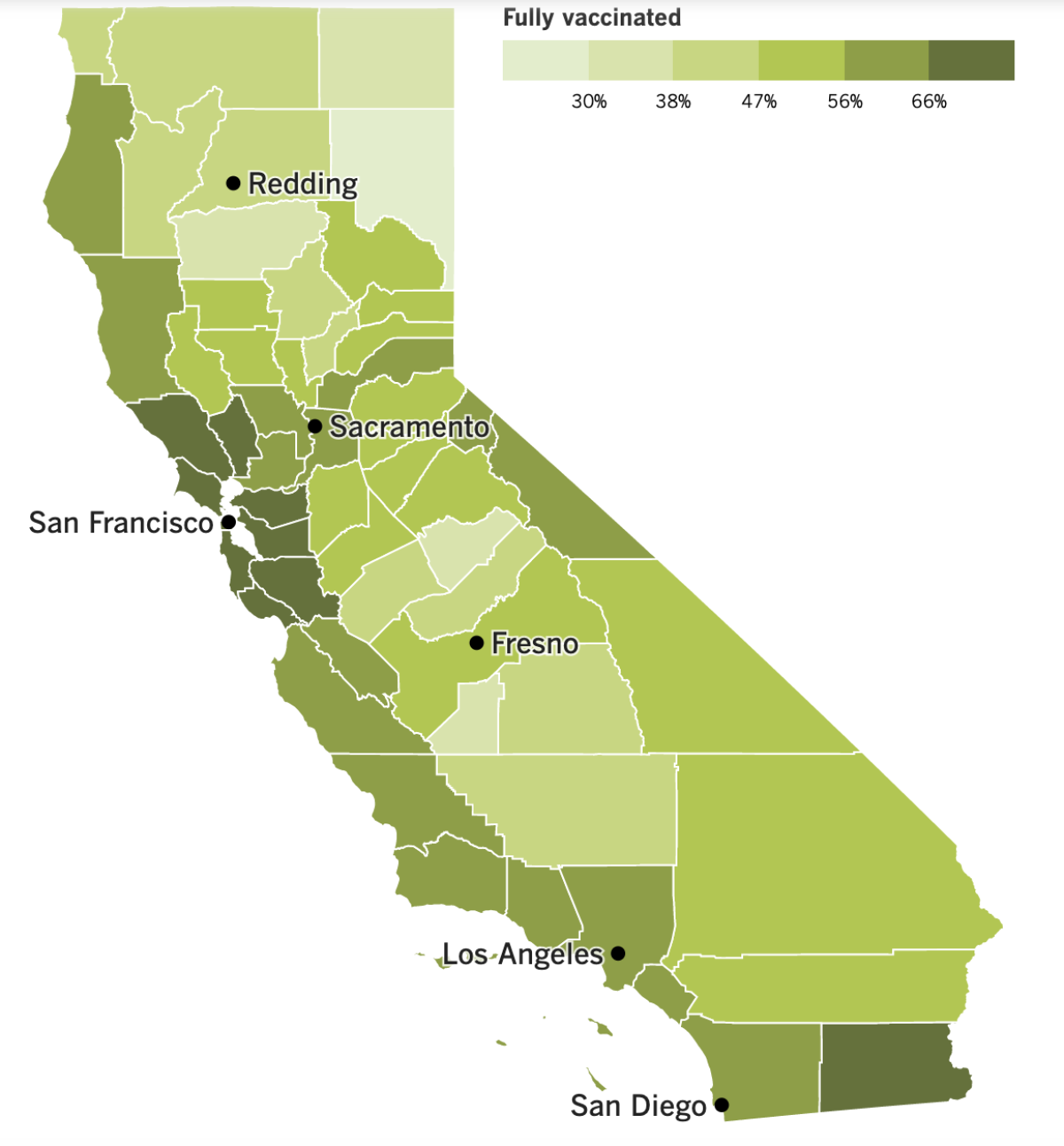
See the latest on California’s vaccination progress with our tracker.
Your support helps us deliver the news that matters most.
In other news ...
Without a doubt, the biggest news since our last edition is Los Angeles’ new law requiring proof of COVID-19 vaccination to eat inside a restaurant, shop inside a mall, see the new James Bond flick inside a theater or get your hair done in a salon.
The rule will apply to all customers who are old enough to receive a COVID-19 vaccine that has received emergency use authorization or full approval from the U.S. Food and Drug Administration.
The L.A. City Council had been scheduled to vote on the ordinance last week, but one council member’s concern about how the new rules would be enforced led to a delay. That member, Joe Buscaino, proposed several amendments, including one that would have made it a crime to cause trouble for workers seeking to enforce the vaccine requirement. The rest opted to vote on the measure in its original form, and it passed Wednesday by a vote of 11-2.
L.A. Mayor Eric Garcetti signed the ordinance the same day.
“These new rules will encourage more people to get the shot, and make businesses safer for workers and customers,” Garcetti said in a statement.
The law will go into effect in a little more than a month, the city attorney’s office said. When it does, venues including coffee shops, gyms, museums and bowling alleys will have to see proof of vaccination before allowing a customer indoors. Those who offer a written exemption for medical or religious reasons will have to use outdoor facilities if they are available.
Businesses that don’t enforce the vaccine mandate can be fined up to $5,000 per violation. The rules will remain in effect until the pandemic winds down enough for the city to lift its emergency declaration.
San Francisco implemented a health order with similar provisions in August. This week, the city led the way again but in a different direction, saying it would lift some of its indoor mask requirements next week.
Starting next Friday, offices, gyms, churches and college classrooms are among the venues that will be able to allow people to remove their masks — but only if everyone inside can provide proof of vaccination. Venue operators also will have to ensure that indoor spaces are properly ventilated and that there are no children under 12 (they’re still too young to be vaccinated), among other things.
If all goes according to plan, San Francisco will become the first Bay Area city to significantly relax indoor face covering rules that were prompted by the Delta surge. But it doesn’t look like it will be the last.
California continues to have the lowest level of coronavirus transmission among the 50 states and the District of Columbia, according to the CDC. And health officials from around the state are reporting that their communities have shaken off the worst of the Delta surge.
As of Friday, 4,314 patients were in California hospitals, according to The Times tracker. That’s a 48% reduction since the summer peak of 8,353 hospitalized patients on Aug. 31. What’s more, the number of new hospitalizations per capita is about half as high as for the nation overall.
Even the state’s hot spots — places including Fresno, Placer and Del Norte counties — that were recently struggling to find enough hospital beds — have seen the number of patients fall dramatically.
The number of new coronavirus cases each day is falling too. Over the last week, California has reported an average of 6,098 new coronavirus cases a day, our tracker shows. That’s less than half the summer peak, when the rolling case average topped 15,000.
As before, vaccinated Californians are faring far better than unvaccinated ones. The Department of Public Health says those who haven’t taken advantage of the shots are about seven times more likely to get COVID-19 and 17 times more likely to die of COVID-19.
Speaking of vaccines, Pfizer has followed through on its pledge to seek emergency use authorization for its COVID-19 vaccine for children ages 5 to 11. The company said Thursday that it filed its request with the U.S. Food and Drug Administration.
In the best-case scenario, the shots could be available to these younger children within a matter of weeks.
The dose for kids in this age group is one-third the dose administered to adolescents and adults. But after two shots, the antibody levels in younger children are comparable to the levels seen in those 12 and up.
FDA scientists are now poring over Pfizer’s data on the vaccine’s safety and efficacy. An independent advisory panel will discuss the application on Oct. 26.
The Moderna vaccine is making news in Scandinavia, where officials are discouraging or suspending its use in people under 30 because of a slightly increased risk of heart inflammation.
The caution was prompted by an unpublished study that found “an increased risk of side effects such as inflammation of the heart muscle or the pericardium,” the sac that covers the heart, according to Sweden’s Public Health Agency. “The risk of being affected is very small,” the agency added.
Sweden put use of the Moderna vaccine on hold for people younger than 30 on Wednesday, and nearby Denmark stopped offering it to people under 18. Norway’s response was to encourage people under 30 to take Pfizer’s vaccine instead.
On Thursday, Finland stopped making the shot available to men under 30.
And finally, North Korea has yet to report a single case of COVID-19, but the World Health Organization has begun shipping medical supplies to the famously closed-off country.
The WHO’s representative to North Korea said Thursday that some of its items had reached the North Korean port of Nampo. Other goods are now stockpiled at the Chinese port of Dalian and are ready to dispatch across the Yellow Sea.
North Korea has told the WHO that all of its 40,700 residents who have been tested for the coronavirus through Sept. 23 received negative results. But outside experts are skeptical of that claim.
COVAX, the United Nations’ vaccine distribution program, has offered 3 million doses of China’s Sinovac shots to North Korea. UNICEF, which handles COVAX’s deliveries, said last month that the offer was declined and that North Korea suggested the shots be sent elsewhere, to countries that were severely affected.
Your questions answered
Today’s question comes from readers who want to know: Do I need to delay my flu shot in order to get a COVID-19 vaccine?
Nope. You can get vaccinated against COVID-19 and the flu during the same trip to the doctor’s office or pharmacy. The same goes for people who are eligible for a COVID-19 booster.
This is not what the Centers for Disease Control and Prevention advised earlier in the pandemic. The CDC used to recommend waiting two weeks between getting a COVID-19 shot and any other type of vaccine. But its current guidelines say that wait is unnecessary.
“Experience with giving other vaccines together has shown the way our bodies develop protection and possible side effects are generally similar whether vaccines are given alone or with other vaccines,” the CDC says.
Getting both shots will help the country avoid a “twindemic” of COVID-19 and influenza. That didn’t happen last year because so many people spent so much time at home during the winter surge — and when they did go out, many wore masks. Whether the flu will return with a vengeance this year is still anybody’s guess.
One piece of advice: Don’t get both vaccines in the same arm. That way, if you have some kind of reaction, it will be easier to tell which shot was responsible.
Of the two, the COVID-19 shot is more likely to cause soreness around the injection site, so that’s the one you should get in your non-dominant arm. (In other words, if you’re a leftie, get the flu shot in your left arm.)
We want to hear from you. Email us your coronavirus questions, and we’ll do our best to answer them. Wondering if your question’s already been answered? Check out our archive here.
The pandemic in pictures
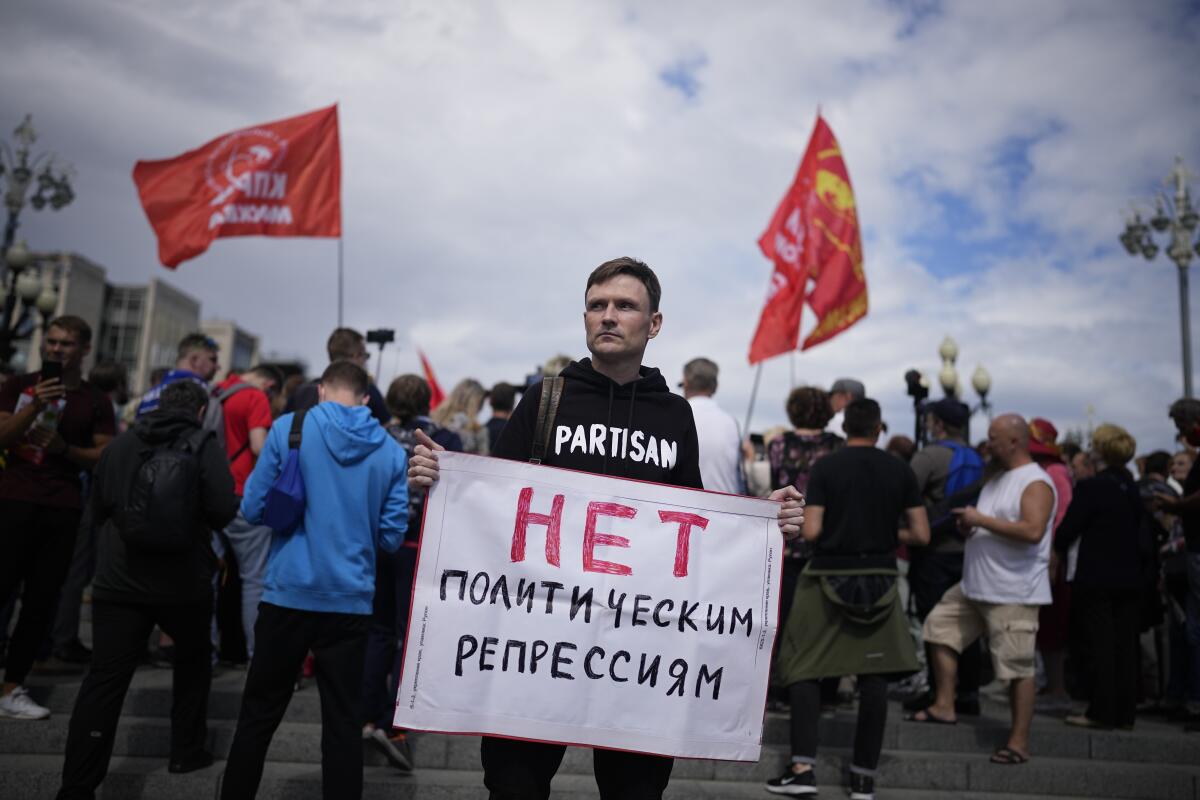
The man in the photo above is at an anti-vaccination protest in Moscow. The sign he’s holding reads, “No political repressions.”
Turns out Americans haven’t cornered the market on anti-vax sentiment.
Only 29% of Russians are fully vaccinated against COVID-19, and about 4% more are partially vaccinated. Thanks in part to that low vaccination rate, the country’s official coronavirus task force reported 929 COVID-19 deaths on Wednesday, followed by another 924 deaths on Thursday and 936 deaths on Friday.
It was the first time Russia’s daily COVID-19 death toll surpassed 900 since the pandemic began more than a year and a half ago.
Resources
Need a vaccine? Keep in mind that supplies are limited, and getting one can be a challenge. Sign up for email updates, check your eligibility and, if you’re eligible, make an appointment where you live: City of Los Angeles | Los Angeles County | Kern County | Orange County | Riverside County | San Bernardino County | San Diego County | San Luis Obispo County | Santa Barbara County | Ventura County
Practice social distancing using these tips, and wear a mask or two.
Watch for symptoms such as fever, cough, shortness of breath, chills, shaking with chills, muscle pain, headache, sore throat and loss of taste or smell. Here’s what to look for and when.
Need to get tested? Here’s where you can in L.A. County and around California.
Americans are hurting in many ways. We have advice for helping kids cope, resources for people experiencing domestic abuse and a newsletter to help you make ends meet.
We’ve answered hundreds of readers’ questions. Explore them in our archive here.
For our most up-to-date coverage, visit our homepage and our Health section, get our breaking news alerts, and follow us on Twitter and Instagram.




